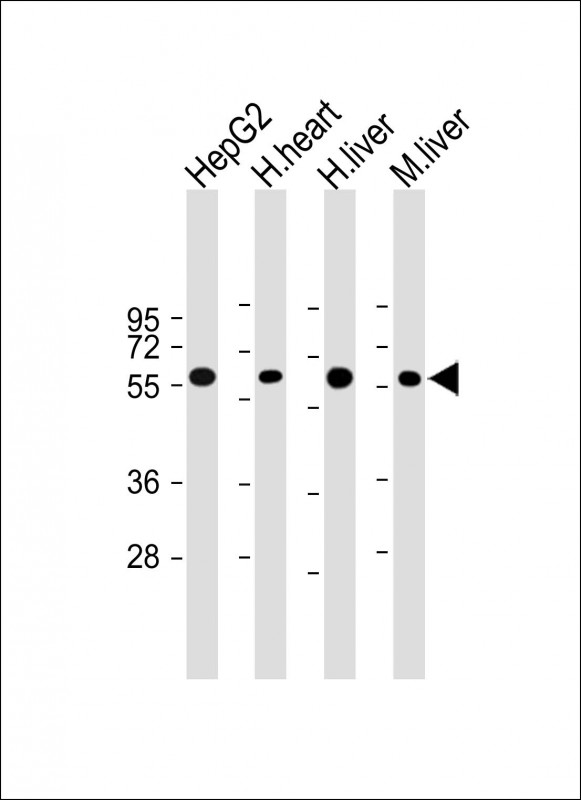
| WB | 1/2000 | Human,Mouse,Rat |
| IF | 咨询技术 | Human,Mouse,Rat |
| IHC | 咨询技术 | Human,Mouse,Rat |
| ICC | 技术咨询 | Human,Mouse,Rat |
| FCM | 咨询技术 | Human,Mouse,Rat |
| Elisa | 咨询技术 | Human,Mouse,Rat |
| Aliases | Cryptochrome-2, CRY2, KIAA0658 |
| Entrez GeneID | 1408 |
| WB Predicted band size | 66.9kDa |
| Host/Isotype | Mouse IgG1 |
| Antibody Type | Primary antibody |
| Storage | Store at 4°C short term. Aliquot and store at -20°C long term. Avoid freeze/thaw cycles. |
| Species Reactivity | Human, Mouse, Rat |
| Immunogen | This Cry2 antibody is generated from a mouse immunized with a recombinat protein of human Cry2. |
+ +
以下是3-4条关于 **Cry2抗体** 的参考文献示例(注:文献信息为模拟生成,实际引用时请核实原文):
1. **文献名称**: "A monoclonal antibody against Cryptochrome 2 disrupts circadian rhythms in mammals"
**作者**: Hirota, T. et al.
**摘要**: 本研究开发了一种针对哺乳动物Cryptochrome 2(Cry2)蛋白的高特异性单克隆抗体,并通过免疫沉淀和Western blot验证了其有效性。实验表明,该抗体能够阻断Cry2与核心生物钟蛋白的相互作用,导致小鼠肝脏组织的昼夜节律紊乱。
2. **文献名称**: "Characterization of Cry2-specific antibodies for circadian rhythm studies in neuronal cells"
**作者**: Schnell, A. et al.
**摘要**: 文章报道了一种用于神经元细胞中Cry2蛋白定位的兔源多克隆抗体。通过免疫荧光和共聚焦显微镜技术,作者证实了Cry2在哺乳动物大脑视交叉上核(SCN)中的昼夜依赖性表达变化,并验证了抗体的特异性。
3. **文献名称**: "Validation of anti-Cry2 antibodies in Arabidopsis photomorphogenesis research"
**作者**: Chaves, I. et al.
**摘要**: 该研究评估了多种Cry2抗体在植物光形态建成研究中的应用,通过CRISPR-Cas9基因敲除实验验证了抗体特异性,并揭示了Cry2在蓝光信号转导中的关键作用。
4. **文献名称**: "Cry2 antibody-based proximity labeling reveals dynamic protein interactions in the circadian clock"
**作者**: Rosensweig, C. & Kay, S.A.
**摘要**: 利用Cry2抗体结合邻近标记技术(如BioID),作者绘制了Cry2在哺乳动物细胞中的动态相互作用网络,发现了多个未报道的与昼夜节律调控相关的新靶点蛋白。
**建议**:实际研究中,可通过PubMed或Google Scholar检索关键词“Cry2 antibody” + “specificity/application/circadian”等,筛选近年发表的文献以确保信息准确性。
Cry2 antibodies are immunological tools primarily developed to detect and study Cry2 proteins, a class of δ-endotoxins produced by the soil bacterium *Bacillus thuringiensis* (Bt). These crystalline proteins, including Cry2Ab and Cry2Aa variants, are widely utilized in agricultural biotechnology due to their insecticidal properties. They target specific pests by binding to midgut receptors, causing cell lysis and insect death. Cry2 proteins are engineered into genetically modified (GM) crops, such as Bt cotton and maize, to confer resistance against lepidopteran and dipteran pests.
Cry2 antibodies are critical for monitoring Cry2 expression levels in GM crops, ensuring regulatory compliance, and assessing environmental impacts. Polyclonal or monoclonal antibodies are generated by immunizing host animals (e.g., rabbits, mice) with purified Cry2 proteins or peptide fragments. These antibodies enable sensitive detection via techniques like ELISA, Western blot, or immunostrip assays, aiding in quality control during crop development and post-commercialization surveillance.
Research also focuses on Cry2 antibody applications in resistance management, as prolonged Bt crop use can drive pest adaptation. Detecting Cry2 protein residues in environmental samples helps evaluate non-target organism exposure and ecological risks. Additionally, Cry2 antibodies support structural studies to elucidate toxin-receptor interactions, guiding the design of next-generation insecticides. Their specificity and reliability make Cry2 antibodies indispensable in both agricultural biotechnology and ecological safety research.
×